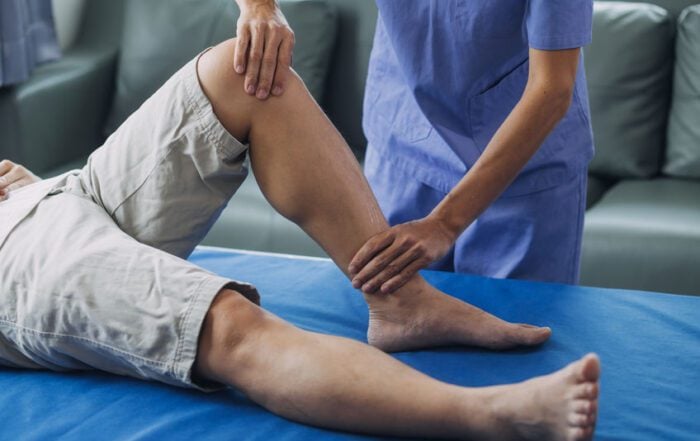The Many Faces Of Lower Back Pain
Back pain is the most common musculoskeletal condition affecting Americans today. Lower back pain, any pain resonating at the base of the spine, affects almost 8% of the population. These figures are expected to rise significantly in the coming years. Lower back pain can restrict everyday movement, work, and social activities if left untreated. The reasons for lower back pain are countless but can usually be narrowed down to spinal, muscular, and nerve issues. At any stage, back pain sufferers can take action to get relief.

Dissecting the lower back
The lower spine consists of 5 bones called vertebrae, which protect the spinal cord. Between each pair of vertebrae are fibrous discs. These discs facilitate the movement of each vertebra and help with shock absorption. Nerves branch out from the spinal cord through spaces in each vertebrae called the neural foramen. Furthermore, each vertebra connects to the other with facet joints and ligaments, allowing the spine to bend. Finally, several muscles attach to the vertebrae and wrap around the lower back for added protection. Here are 3 common reasons for lower back pain.
1. Is it a disc issue?
The intervertebral discs bear the weight of the upper body and spine. These are therefore prone to damage. Discs contain liquid like water and, over time, can lose hydration. As a result, the disc loses size and strength, creating a condition called degenerative disc disease. In other cases, the inner nucleus of the disc can bulge out of place. Herniated and degenerative discs press on nearby nerves causing lower back pain and stiffness. The irritation of nerves leads to further inflammation and pain that radiates down the legs.
2. Weakened lower back muscles
Doctors can link most cases of back pain to weakened back muscles. As the muscles become underused, there is increased difficulty in holding the spine in place. Added pressure goes onto the joints, discs, and nerves. Therefore, pain can happen when someone then decides to activate the back muscles for physical activity. The lack of movement also causes muscles to become stiff, causing pain even when stationary. A sedentary lifestyle is one of the biggest reasons for back pain, with the average American sitting over 7 hours daily. As a result, muscles can weaken over time, leading to chronic pain.
3. Possible joint dysfunction
Facet joints connect the vertebrae and help with movement, but at the base of the spine lies the sacroiliac (SI) joint. This powerful joint connects the spine to the pelvis and helps support the weight of the entire upper body. Due to overuse, for instance, in highly physical jobs, this joint can become inflamed. Doctors may also uncover sacroiliac joint dysfunction, where the SI joint does not move properly, leading to pain.
What can you do about your pain?
The first thing a patient with acute or chronic lower back pain should do is see a doctor or spinal specialist as soon as possible. Delaying the issue can lead to more severe conditions. The doctor can help with treatment, including pain management and physical therapy. Exercise is also essential. Strengthening the back muscles can reduce the chances of chronic conditions. Start with brisk walks, then move to doctor-recommended strength exercises. If these options fail, a surgeon can recommend surgery for long-term relief.
Recent Posts
ACL Repair: Will You Have Range Of Motion With Your Knee After Recovery & Physical Therapy?
After an ACL injury, ROM can be negatively affected. ACL repair surgery helps restore function, but physical therapy is essential to ROM.
Arthroscopy: What Are The Benefits Of This Minimally Invasive Outpatient Orthopedic Procedure?
Arthroscopy can help diagnose or treat joint conditions. Benefits of the MIS include faster recovery, less pain, and fewer scars.
Posterior Interbody Lumbar Fusion: What Are The Benefits Of PLIF For People With Back Pain?
People with chronic back pain may benefit from posterior interbody lumbar fusion surgery. PLIF can reduce pain and improve stability.
Saying Goodbye To Tonsil Troubles: The Benefits Of Minimally Invasive Tonsillectomy
Chronic tonsilitis or other tonsil troubles can impact health and well-being. A minimally invasive tonsillectomy can reduce infections.
“Everyone was friendly and the place was very clean.”
“I liked that it was so clean. Every staff member was pleasant and easy to talk with.”
“The staff was very polite, they were excellent. They explained exactly what was going on.”
“Entire staff was knowledgeable and courteous. They genuinely cared for my well being and made sure my wife and I were taken care of.”
“The nurses were very nice and caring!”
“Everyone was concerned with my comfort.”
“All staff were wonderful.”
“Incredibly professional, friendly and confidence of knowing their roles as healthcare employees. Excellent!”
“Marcia and staff were excellent and genuinely cared for my well being. Wish I could have taken them home.”
“Experience was amazing. The nurses my son needed at this time couldn’t have been chosen any more perfect. They were supportive and understanding, patient and just great human beings.THANK YOU KINDLY ”
“Dr. Dedhia made everything clear and even scheduled an early follow-up appt so I could get back to work sooner.”
“Everyone was friendly and concerned about my comfort. They frequently asked how I was doing, or if I needed something.”
“All staff were wonderful.”
“NO wait time, RN Rebecca answered all questions prior to my visit by phone and again answered all questions and concerns while prepping me.”
“Dr. Best…is the best!”
“Amazing nurses, very caring and friendly and put both me and my son at ease.”
“I liked that it was so clean. Every staff member was pleasant and easy to talk with.”
“No severe pain – Just a little discomfort – I was asked several times during procedure if I was OK – they showed genuine concern for my well being.”
“Anesthesia staff was outstanding!”
“The nurses were very nice and caring!”
“The staff was great, especially Mary and Marcia. Marcia was extremely helpful post-op and made sure I was comfortable and well-cared for.”
“Marcia and staff were excellent and genuinely cared for my well being. Wish I could have taken them home.”
“The staff was very polite, they were excellent. They explained exactly what was going on.”
“Dr. Best…is the best!”
“Dr. Dedhia made everything clear and even scheduled an early follow-up appt so I could get back to work sooner.”
“Efficiency of the staff. Courteous, friendly and caring attitude. Excellent office staff. Pleasant surroundings.”
“Everyone was friendly and concerned about my comfort. They frequently asked how I was doing, or if I needed something.”
“Dr. Tupper was amazing! He spent time explaining exactly what he was doing, what I would experience and made sure I was comfortable.”
“Experience was amazing. The nurses my son needed at this time couldn’t have been chosen any more perfect. They were supportive and understanding, patient and just great human beings.THANK YOU KINDLY ”
“Efficiency of the staff. Courteous, friendly and caring attitude. Excellent office staff. Pleasant surroundings.”
“Rebecca was amazing. I have always had trouble in the past with getting an IV started. I told Rebecca I was concerned about it. She got it on the 1st try – no digging in my arm and NO bruising the next day.”
“Rebecca was amazing. I have always had trouble in the past with getting an IV started. I told Rebecca I was concerned about it. She got it on the 1st try – no digging in my arm and NO bruising the next day.”
“Entire staff was knowledgeable and courteous. They genuinely cared for my well being and made sure my wife and I were taken care of.”
“Dr. Tupper was amazing! He spent time explaining exactly what he was doing, what I would experience and made sure I was comfortable.”
“No severe pain – Just a little discomfort – I was asked several times during procedure if I was OK – they showed genuine concern for my well being.”
“Everyone was concerned with my comfort.”
“Amazing nurses, very caring and friendly and put both me and my son at ease.”
“The staff was great, especially Mary and Marcia. Marcia was extremely helpful post-op and made sure I was comfortable and well-cared for.”
“Incredibly professional, friendly and confidence of knowing their roles as healthcare employees. Excellent!”
“I can’t say enough about Marcia and the entire team. The care I received was well beyond anything I could have expected.”
“Anesthesia staff was outstanding!”
“NO wait time, RN Rebecca answered all questions prior to my visit by phone and again answered all questions and concerns while prepping me.”
“The STAFF from the moment you walk in were the nicest people I’ve encountered at a medical facility.”
“Everyone was friendly and the place was very clean.”
“I can’t say enough about Marcia and the entire team. The care I received was well beyond anything I could have expected.”
“The STAFF from the moment you walk in were the nicest people I’ve encountered at a medical facility.”
Recent Posts
ACL Repair: Will You Have Range Of Motion With Your Knee After Recovery & Physical Therapy?
After an ACL injury, ROM can be negatively affected. ACL repair surgery helps restore function, but physical therapy is essential to ROM.
Arthroscopy: What Are The Benefits Of This Minimally Invasive Outpatient Orthopedic Procedure?
Arthroscopy can help diagnose or treat joint conditions. Benefits of the MIS include faster recovery, less pain, and fewer scars.
Posterior Interbody Lumbar Fusion: What Are The Benefits Of PLIF For People With Back Pain?
People with chronic back pain may benefit from posterior interbody lumbar fusion surgery. PLIF can reduce pain and improve stability.
Saying Goodbye To Tonsil Troubles: The Benefits Of Minimally Invasive Tonsillectomy
Chronic tonsilitis or other tonsil troubles can impact health and well-being. A minimally invasive tonsillectomy can reduce infections.








